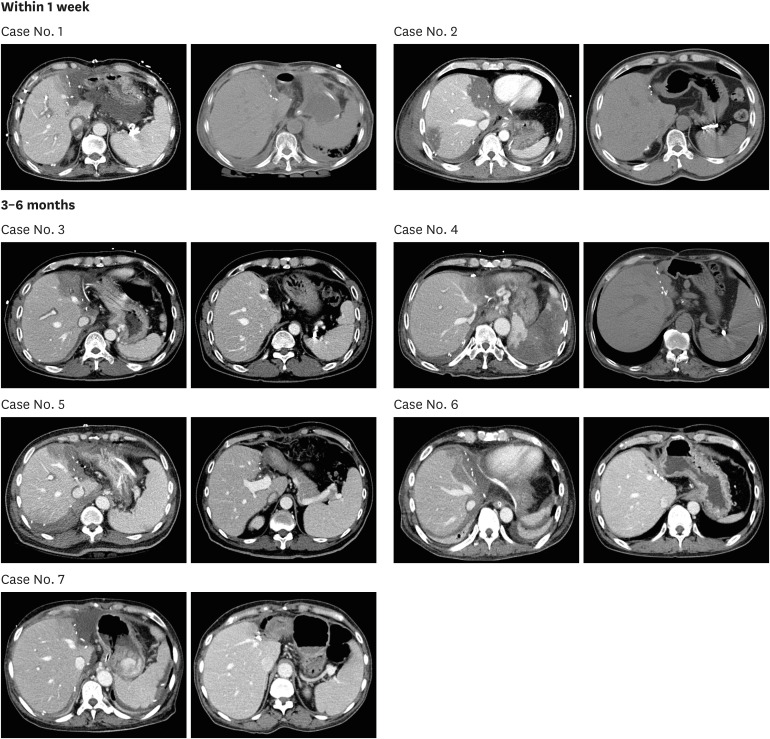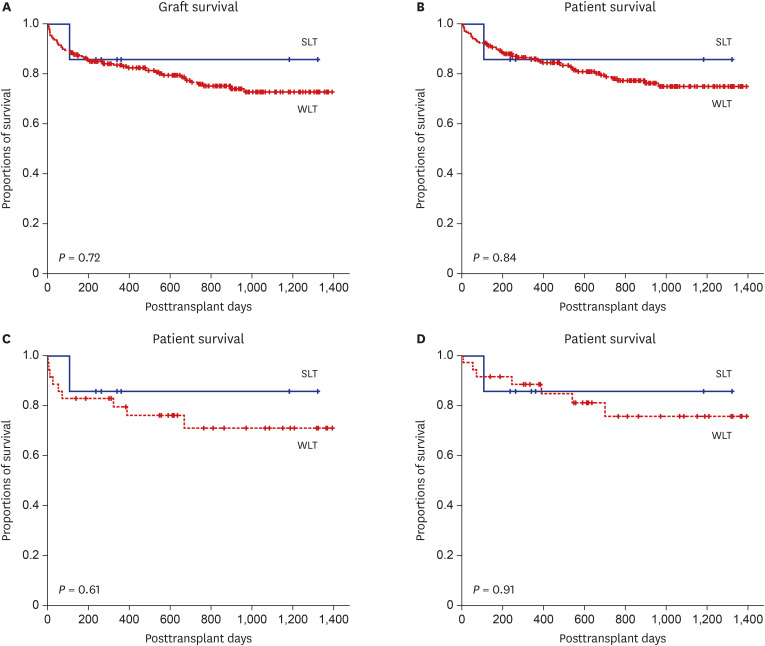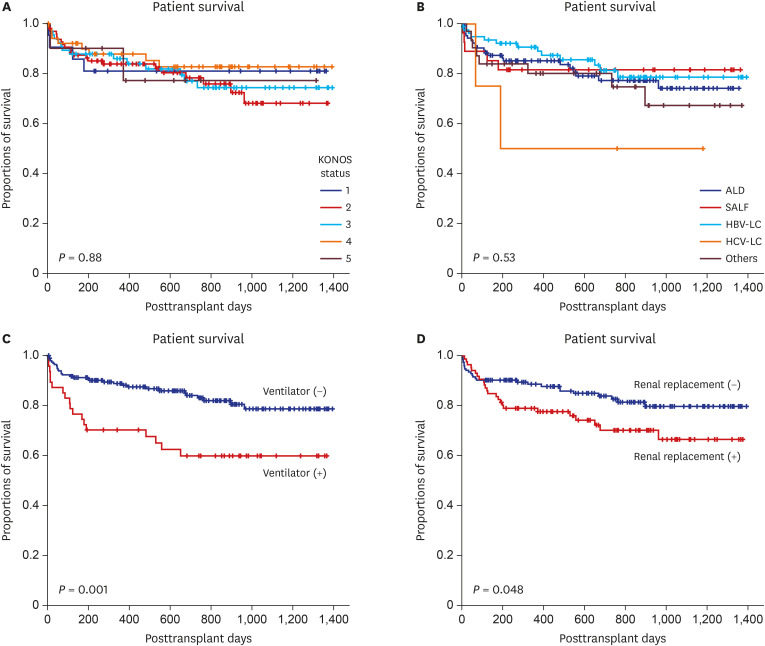J Korean Med Sci.
2020 Sep;35(37):e304. 10.3346/jkms.2020.35.e304.
Prognosis of Split Liver Transplantation Compared with Whole Liver Transplantation in Adult Patients: Single-center Results under the Korean MELD Score-based Allocation Policy
- Affiliations
-
- 1Division of Hepatobiliary Surgery and Liver Transplantation, Department of Surgery, Asan Medical Center, University of Ulsan College of Medicine, Seoul, Korea
- KMID: 2506560
- DOI: http://doi.org/10.3346/jkms.2020.35.e304
Abstract
- Background
Split liver transplantation (SLT) has been occasionally performed in Korea. This study compared the incidence and prognosis of SLT with whole liver transplantation (WLT) in adult patients.
Methods
Between June 2016 and November 2019, 242 adult patients underwent a total of 256 deceased donor liver transplantation operations. SLT was performed in 7 patients (2.9%).
Results
The mean age of SLT donors was 29.7 ± 7.4 years, and the mean age of recipients was 55.7 ± 10.6 years, with the latter having a mean model for end-stage liver disease score of 34.6 ± 3.1. Mean split right liver graft weight was 1,228.6 ± 149.7 g and mean graft-recipient weight ratio was 1.97 ± 0.39. Of the seven SLT recipients, Korean Network for Organ Sharing (KONOS) status was one in status 1, one in status 2 and five in status 3. The graft (p = 0.72) and patient (p = 0.84) survival rates were comparable in the SLT and WLT groups. Following propensity score matching, graft (p = 0.61) and patient (p = 0.91) survival rates remained comparable in the two groups. Univariate analysis showed that pretransplant ventilator support and renal replacement therapy were significantly associated with patient survival, whereas KONOS status category and primary liver diseases were not. Multivariate analysis showed that pretransplant ventilator support was an independent risk factor for patient survival.
Conclusion
Survival outcomes were similar in adult SLT and WLT recipients, probably due to selection of high-quality grafts and low-risk recipients. Prudent selection of donors and adult recipients for SLT may expand the liver graft pool for pediatric patients without affecting outcomes in adults undergoing SLT.
Figure
Cited by 1 articles
-
Clinical sequence of an adult recipient undergone split liver transplantation using a right liver graft with erroneous deprivation of the middle hepatic vein trunk: a case report
Geunhyeok Yang, Shin Hwang, Chul-Soo Ahn, Tae-Yong Ha, Dong-Hwan Jung
Korean J Transplant. 2021;35(3):189-194. doi: 10.4285/kjt.21.0010.
Reference
-
1. Pichlmayr R, Ringe B, Gubernatis G, Hauss J, Bunzendahl H. Transplantation of a donor liver to 2 recipients (splitting transplantation)--a new method in the further development of segmental liver transplantation. Langenbecks Arch Chir. 1988; 373(2):127–130. PMID: 3287073.2. Broelsch CE, Emond JC, Whitington PF, Thistlethwaite JR, Baker AL, Lichtor JL. Application of reduced-size liver transplants as split grafts, auxiliary orthotopic grafts, and living related segmental transplants. Ann Surg. 1990; 212(3):368–375. PMID: 2396888.
Article3. Renz JF, Yersiz H, Reichert PR, Hisatake GM, Farmer DG, Emond JC, et al. Split-liver transplantation: a review. Am J Transplant. 2003; 3(11):1323–1335. PMID: 14525591.
Article4. Adam R, McMaster P, O'Grady JG, Castaing D, Klempnauer JL, Jamieson N, et al. Evolution of liver transplantation in Europe: report of the European Liver Transplant Registry. Liver Transpl. 2003; 9(12):1231–1243. PMID: 14625822.
Article5. Superina R. To split or not to split: that is the question. Liver Transpl. 2012; 18(4):389–390. PMID: 22287492.
Article6. Chul Yoon K, Song S, Jwa EK, Lee S, Man Kim J, Kim OK, et al. Survival outcomes in split compared with whole liver transplantation. Liver Transpl. 2018; 24(10):1411–1424. PMID: 29747216.
Article7. Jung DH, Hwang S, Song GW, Ahn CS, Moon DB, Kim KH, et al. In situ split liver transplantation for 2 adult recipients: a single-center experience. Ann Transplant. 2017; 22:230–240. PMID: 28428535.
Article8. Kim JS, Broering DC, Tustas RY, Fischer L, Ganschow R, Burdelski M, et al. Split liver transplantation: past, present and future. Pediatr Transplant. 2004; 8(6):644–648. PMID: 15598341.
Article9. Cardillo M, De Fazio N, Pedotti P, De Feo T, Fassati LR, Mazzaferro V, et al. Split and whole liver transplantation outcomes: a comparative cohort study. Liver Transpl. 2006; 12(3):402–410. PMID: 16598843.
Article10. Suh KS, Lee HW, Shin WY, Cho EH, Yi NJ, Lee KU. Split liver transplantation. J Korean Soc Transplant. 2007; 21:135–139.11. Lee S, Lee SK. Pediatric liver transplantation. J Korean Assoc Pediatr Surg. 2013; 19(1):14–21.
Article12. Min SI, Ahn C, Han DJ, Kim SI, Chung SY, Lee SK, et al. To achieve national self-sufficiency: recent progresses in deceased donation in Korea. Transplantation. 2015; 99(4):765–770. PMID: 25226175.13. Ha SM, Hwang S, Song GW, Ahn CS, Moon DB, Ha TY, et al. Successful introduction of model for end-stage liver disease scoring in deceased donor liver transplantation in Korea: analysis of first 1 year experience at a high-volume transplantation center. Ann Hepatobiliary Pancreat Surg. 2017; 21(4):199–204. PMID: 29264582.
Article14. Ha HS, Hong JJ, Kim IO, Lee SR, Lee AY, Ha TY, et al. Deceased donor liver transplantation under the Korean model for end-stage liver disease score-based liver allocation system: 2-year allocation results at a high-volume transplantation center. Korean J Transplant. 2019; 33(4):112–117.
Article15. Park GC, Hwang S, Jung DH, Song GW, Ahn CS, Kim KH, et al. Is renal replacement therapy necessary in deceased donor liver transplantation candidates with hepatorenal syndrome?: a 2-year experience at a high-volume center. Ann Surg Treat Res. 2020; 98(2):102–109. PMID: 32051819.
Article16. Yersiz H, Renz JF, Farmer DG, Hisatake GM, McDiarmid SV, Busuttil RW. One hundred in situ split-liver transplantations: a single-center experience. Ann Surg. 2003; 238(4):496–505. PMID: 14530721.17. Hwang S, Lee SG, Park KM, Kim KH, Ahn CS, Moon DB, et al. A case report of split liver transplantation for two adult recipients in Korea. Transplant Proc. 2004; 36(9):2736–2740. PMID: 15621136.
Article18. Gavriilidis P, Roberts KJ, Azoulay D. Right lobe split liver graft versus whole liver transplantation: a systematic review by updated traditional and cumulative meta-analysis. Dig Liver Dis. 2018; 50(12):1274–1282. PMID: 30236766.
Article19. Hwang S, Lee SG, Lee YJ, Park KM, Ahn CS, Kim KH. Postoperative changes in remnant medial segment parenchyma of living donor livers after procurement of left lateral segment graft. Hepatogastroenterology. 2006; 53(71):773–777. PMID: 17086886.20. Merion RM, Rush SH, Dykstra DM, Goodrich N, Freeman RB Jr, Wolfe RA. Predicted lifetimes for adult and pediatric split liver versus adult whole liver transplant recipients. Am J Transplant. 2004; 4(11):1792–1797. PMID: 15476478.
Article21. Jassem W, Heaton ND, Rela M. Reducing bile leak following segmental liver transplantation: understanding biliary anatomy of the caudate lobe. Am J Transplant. 2008; 8(2):271–274. PMID: 18162089.
Article22. Wojcicki M, Silva MA, Jethwa P, Gunson B, Bramhall SR, Mayer D, et al. Biliary complications following adult right lobe ex vivo split liver transplantation. Liver Transpl. 2006; 12(5):839–844. PMID: 16628692.
Article23. Guo S, Fraser MW. Propensity Score Analysis: Statistical Methods and Applications. Los Angeles, CA: SAGE Publications, Inc;2010.24. Suh KS, Lee KW, Koh YT, Roh HR, Chung JK, Minn KW, et al. First successful in situ split-liver transplantation in Korea. Transplant Proc. 2000; 32(7):2140. PMID: 11120105.
Article25. Cho WH. Organ donation in Korea in 2018 and an introduction of the Korea national organ donation system. Korean J Transplant. 2019; 33(4):83–97.
Article26. Choi Y, Lee KW, Hong G, Kim H, Park MS, Suh S, et al. Status and current problems in the allocation system for pediatric liver transplantation in Korea. J Korean Soc Transplant. 2012; 26(3):196–201.
Article27. Sepulveda A, Scatton O, Tranchart H, Gouya H, Perdigao F, Stenard F, et al. Split liver transplantation using extended right grafts: the natural history of segment 4 and its impact on early postoperative outcomes. Liver Transpl. 2012; 18(4):413–422. PMID: 22144403.
Article28. Hashimoto K, Quintini C, Aucejo FN, Fujiki M, Diago T, Watson MJ, et al. Split liver transplantation using Hemiliver graft in the MELD era: a single center experience in the United States. Am J Transplant. 2014; 14(9):2072–2080. PMID: 25040819.
Article29. Chaib E, Ribeiro MA Jr, Saad WA, Gama-Rodrigues J. The main hepatic anatomic variations for the purpose of split-liver transplantation. Transplant Proc. 2005; 37(2):1063–1066. PMID: 15848623.
Article30. Jin GY, Yu HC, Lim HS, Moon JI, Lee JH, Chung JW, et al. Anatomical variations of the origin of the segment 4 hepatic artery and their clinical implications. Liver Transpl. 2008; 14(8):1180–1184. PMID: 18668651.
Article31. Renz JF, Emond JC, Yersiz H, Ascher NL, Busuttil RW. Split-liver transplantation in the United States: outcomes of a national survey. Ann Surg. 2004; 239(2):172–181. PMID: 14745324.
- Full Text Links
- Actions
-
Cited
- CITED
-
- Close
- Share
- Similar articles
-
- Current Status of Deceased Donor Liver Transplantation for Alcoholic Liver Disease in Korea in MELD Era
- Pediatric liver transplantation in Korea: long-term outcomes and allocations
- Comparison Study of Outcomes of Deceased Donor Liver Transplantation before and after Korean Model for End-Stage Liver Disease (MELD) System: Single Center Experience
- Absence of influence of the Korean MELD score-based liver allocation system on pretransplant MELD score in patients undergoing living donor liver transplantation
- Deceased donor liver transplantation under Korean MELD score-based liver allocation system at a high-volume transplantation center




